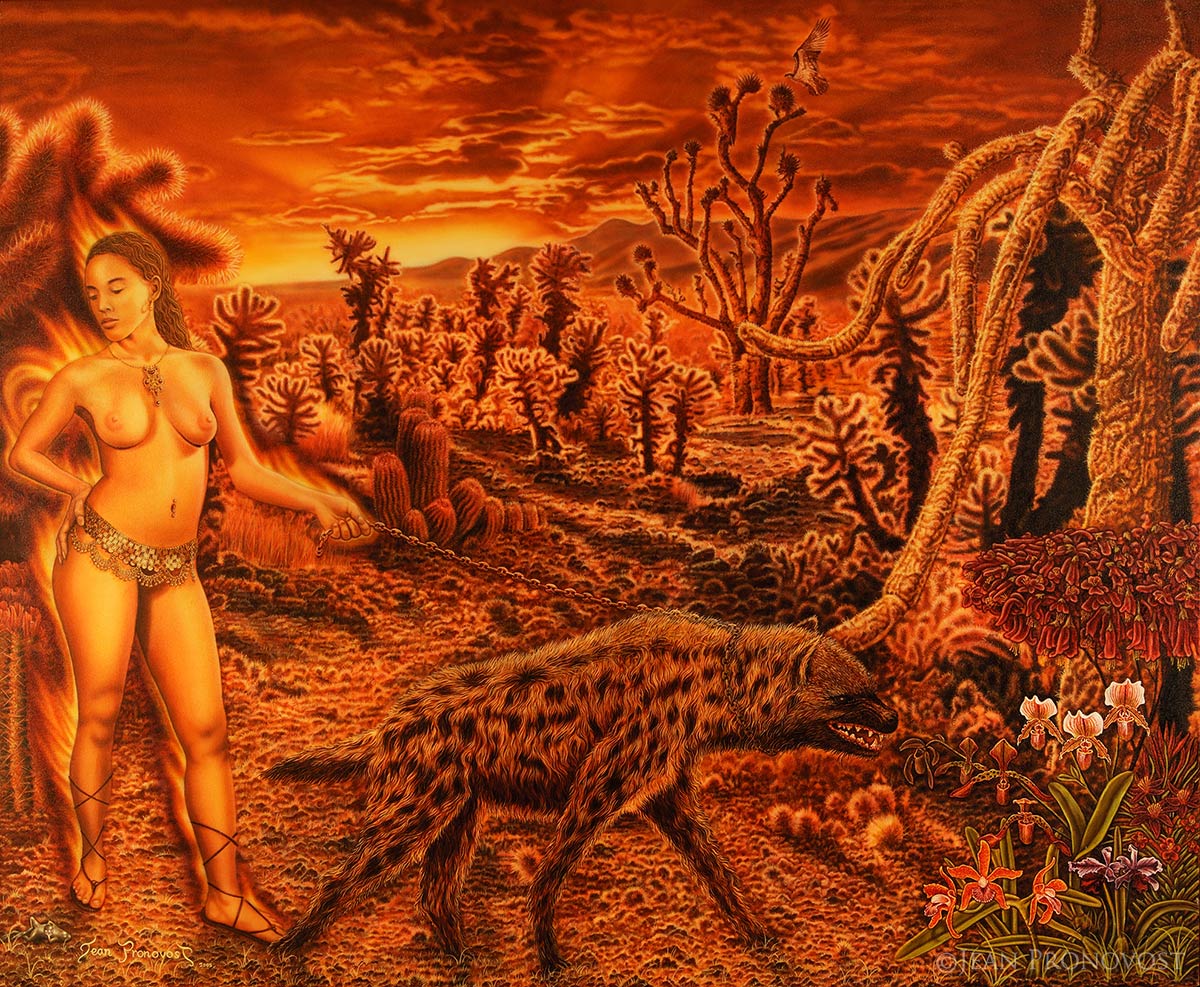CONTEMPOREVE by jean pronovost
Here in this Northern Mexico desert landscape, a sacred place of the Huichol natives, we see a contemporary Eve with a hyena. This symbolically charged painting, largely executed in fiery, organic, warm shades of brown and orange, offers us a mirror to ourselves through irony: Eve’s carefree attitude, willful blindness, and narcissism come with a heavy price – her life, self, and spirit. She is us: we constantly end up paying too much attention to shallow and fleeting things like jewelry and latest fashion trends, we distract ourselves with these charming beauties and ignore the truth of existence and the nature around us. When you approach this painting, there is no doubt the first element you are drawn to is her bare breasts and nearly naked body. But if you dwell on that one aspect of the painting, overlooking the greater picture and profound meaning at work, then you are just like her! Prove the painter wrong – show him you can look beyond her beautiful body, contemplate the layers of symbolism in this scene, and arrive at knowledge that enriches your mind and soul.
When we look across this desert, what is immediately felt is how harsh and unforgiving this environment is. The intense and rich shades of orange and brown tell us this landscape is one that can present great challenges and dangers to us. There is the dry sand, cactuses covered in sharp needles, trees that are more bark than foliage, and the countless insects, snakes, and scorpions that hide in its crevices. There are no places to hide from predatory animals and no soft place to rest; there is no shade to find relief from the scorching sun and no water to drink should you run out.
This painting has two lines of composition that serve as the foundation for the two choices of life path one can take. One goes from the left corner at Eve’s feet up to the tree and then to the eagle in the sky. The eagle is in flight, it symbolizes the spiritual state of mind and ancient wisdom. This is the way we should all go – nature’s path, the absolute, the mountains, and all that is sacred. This includes the completion of yourself as a spiritual being. The other line goes from Eve’s head down the chain that holds the hyena and then to the orchids in the right corner. This way leads to a failure of the soul and denial of enlightenment.
The aura of Eve is on fire, it is burning, and that is symbolic of the state of her soul and mind. Her facial expression and eyes lightly closed tell us that she is oblivious and ignorant. What she is wearing, or rather not wearing, is so wildly inappropriate for this landscape. It’s more about fashion and beauty than function and safety. She is practically naked except for sandals and some jewelry. She wears a mix of ancient and modern accessories: around her waist is Roman-style chain belt, at her neck a Mesopotamian-styled necklace, then we see Arabian-styled naval and nose jewelry, and modern earrings, etc. This blend of old and new world fashion enables her to represent women of all eras, and on a grander scale, the painter wants us to see her as symbolic of all humans – how we act and what we are, what we believe, and how we treat the earth.
Eve does not seem to notice the dead frog at her feet that holds a cracked pearl, both symbolizing how we have corrupted the environment and the fertility of animals. The frog is the first one to suffer when the water is polluted, and habitat destroyed. She also does not care that she has used a flimsy decorative chain to harness the hyena, a rather dangerous animal. At any moment, it could turn around and attack her; she is not in control at all. This chain symbolizes how we see ourselves as the pinnacle of all creation; it is the chain of evolution, and we are the master over animals, plants, and all resources. Another irony comes to light here in that it is we who are the real slaves, not the animals – to our greed, desire for power, beauty, and commodities.
Near the hyena’s mouth are some orchids, which should strike you as very odd since they do not grow in the desert. The flower about to be consumed is dying, it is brown and wilted. These beautiful, but misplaced flowers are a further representation of how we treat our world: we expect things to grow where we desire them to be and not according to natural design. We think we know better than nature. This painting, and specifically this line of composition, reveals to us how we have polluted and perverted the landscape. With our attitude, everything suffers. But like Eve with the hyena, we can only keep nature on this weak and imaginary restraint for so long. This world will eventually turn the tables, attack us, and remind us that we are one of many species existing – not the top. Eve’s breasts cannot save you from this fate, but if you can look past them to the eagle and go deep inside yourself, there is hope.

